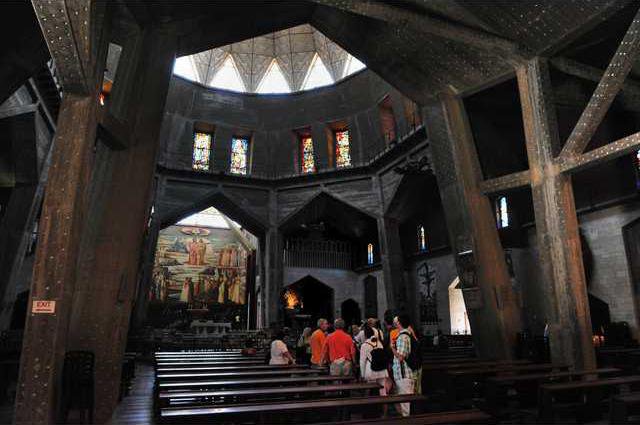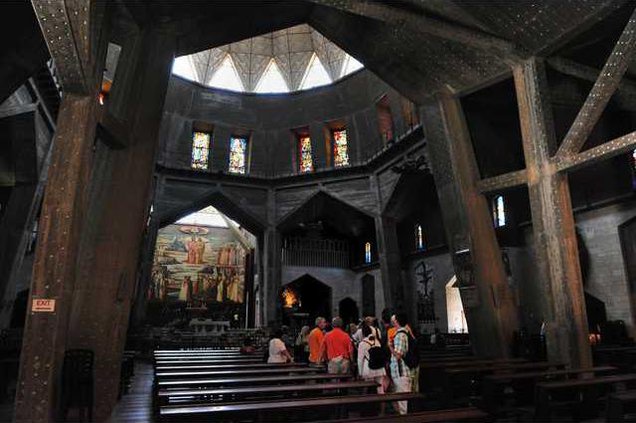The impressive Roman Catholic Basilica of the Annunciation in Nazareth was dedicated in 1969 and is among the most beautiful churches in the Holy Land. It stands on the site of an earlier Crusader-era sanctuary that had been built near the beginning of the 12th century and was destroyed roughly 150 years later. And that church, in turn, had been built on the ruins of a shrine commissioned by the Emperor Constantine in the first part of the fourth century. Surviving documents indicate that it was still in existence in A.D. 570, but it had been destroyed by the dawn of the eighth century.
The Basilica marks the traditional location of the Virgin Marys childhood home, where Catholics have long believed that the angel Gabriel appeared to her to herald the birth of Jesus Christ. (Greek Orthodox tradition holds that Gabriel visited her while she was drawing water from a nearby spring, so an alternative Church of the Annunciation was erected at that site.)
Most Christian tour groups in Israel visit the Catholic Basilica of the Annunciation, but relatively few, Im guessing, pay much attention to the unspectacular Sisters of Nazareth Convent that sits, enclosed by a wall, directly adjacent to it. Yet as Ken Dark, director of the Research Centre for Late Antiquity and Byzantine Studies at Englands University of Reading, reports in the current issue of the Biblical Archaeology Review, some very interesting discoveries have been made there in recent generations.
Surprisingly little archaeological work has been done within the city of Nazareth. In the 1880s, however, shortly after the convent was built, an ancient cistern was discovered there. So the nuns undertook excavations, helped by construction workmen and even the children from their school. To their delight, they uncovered walls and vaults from the Crusader period, a Byzantine cave-church, Roman-period tombs, pottery, coins, glass and other artifacts, on the basis of which they created a small museum.
In 1936, a former architect turned Jesuit priest, Father Henri Senes, launched renewed excavations and, more importantly, created notes and detailed records of his own finds and those of the previous several decades. Never published, Father Senes notes and drawings have now been made available by the Sisters of Nazareth to Dark and his research team, who began to examine the site again in 2006.
Darks article the details of which I cant begin to provide here, in this short column focuses on a structure, partially cut into the rock of a hillside and partly constructed of stone, that he dates to the early first century or before. It was, he says, most likely a domestic residence. And the presence in it of limestone vessels suggests that those who lived there were almost certainly Jews. (Limestone vessels couldnt become ritually impure under the rules of Jewish law.)
The structure is exceptionally well-preserved because the builders of both Byzantine and Crusader churches (roughly contemporary with the churches of the Annunciation next door) made great efforts to encompass the remains of this building. It seems quite likely, Dark argues, based on not only archaeological evidence but also on very ancient pilgrim descriptions, that the builders of the Byzantine church on the site many centuries closer to the time of Jesus Christ than we are believed themselves to be preserving and protecting the home of Joseph and Mary, the place where Jesus spent his childhood in Nazareth.
Was this the house where Jesus grew up? he asks. It is impossible to say on archaeological grounds. On the other hand, there is no good archaeological reason why such an identification should be discounted.
More broadly, based on research not only in Nazareth generally but in the adjoining city of Sepphoris and in the agricultural area between them, Dark says that the evidence suggests that Jesus boyhood was spent in a conservative Jewish community that had little contact with Hellenistic or Roman culture.
Here, he takes specific aim at such authors as Burton Mack and John Dominic Crossan, of the so-called Jesus Seminar, whove claimed that Jesus was more heavily influenced by Greek ideas, and specifically by the Greek philosophical movement known as cynicism, than by Jewish prophetic teachings. The archaeological data, however, dont seem to support this brand of speculative biblical studies. The actual Nazareth of the historical first century, Dark writes, is extremely unlikely to be the sort of place where one would have encountered 'cynic' philosophy.
The Basilica marks the traditional location of the Virgin Marys childhood home, where Catholics have long believed that the angel Gabriel appeared to her to herald the birth of Jesus Christ. (Greek Orthodox tradition holds that Gabriel visited her while she was drawing water from a nearby spring, so an alternative Church of the Annunciation was erected at that site.)
Most Christian tour groups in Israel visit the Catholic Basilica of the Annunciation, but relatively few, Im guessing, pay much attention to the unspectacular Sisters of Nazareth Convent that sits, enclosed by a wall, directly adjacent to it. Yet as Ken Dark, director of the Research Centre for Late Antiquity and Byzantine Studies at Englands University of Reading, reports in the current issue of the Biblical Archaeology Review, some very interesting discoveries have been made there in recent generations.
Surprisingly little archaeological work has been done within the city of Nazareth. In the 1880s, however, shortly after the convent was built, an ancient cistern was discovered there. So the nuns undertook excavations, helped by construction workmen and even the children from their school. To their delight, they uncovered walls and vaults from the Crusader period, a Byzantine cave-church, Roman-period tombs, pottery, coins, glass and other artifacts, on the basis of which they created a small museum.
In 1936, a former architect turned Jesuit priest, Father Henri Senes, launched renewed excavations and, more importantly, created notes and detailed records of his own finds and those of the previous several decades. Never published, Father Senes notes and drawings have now been made available by the Sisters of Nazareth to Dark and his research team, who began to examine the site again in 2006.
Darks article the details of which I cant begin to provide here, in this short column focuses on a structure, partially cut into the rock of a hillside and partly constructed of stone, that he dates to the early first century or before. It was, he says, most likely a domestic residence. And the presence in it of limestone vessels suggests that those who lived there were almost certainly Jews. (Limestone vessels couldnt become ritually impure under the rules of Jewish law.)
The structure is exceptionally well-preserved because the builders of both Byzantine and Crusader churches (roughly contemporary with the churches of the Annunciation next door) made great efforts to encompass the remains of this building. It seems quite likely, Dark argues, based on not only archaeological evidence but also on very ancient pilgrim descriptions, that the builders of the Byzantine church on the site many centuries closer to the time of Jesus Christ than we are believed themselves to be preserving and protecting the home of Joseph and Mary, the place where Jesus spent his childhood in Nazareth.
Was this the house where Jesus grew up? he asks. It is impossible to say on archaeological grounds. On the other hand, there is no good archaeological reason why such an identification should be discounted.
More broadly, based on research not only in Nazareth generally but in the adjoining city of Sepphoris and in the agricultural area between them, Dark says that the evidence suggests that Jesus boyhood was spent in a conservative Jewish community that had little contact with Hellenistic or Roman culture.
Here, he takes specific aim at such authors as Burton Mack and John Dominic Crossan, of the so-called Jesus Seminar, whove claimed that Jesus was more heavily influenced by Greek ideas, and specifically by the Greek philosophical movement known as cynicism, than by Jewish prophetic teachings. The archaeological data, however, dont seem to support this brand of speculative biblical studies. The actual Nazareth of the historical first century, Dark writes, is extremely unlikely to be the sort of place where one would have encountered 'cynic' philosophy.

